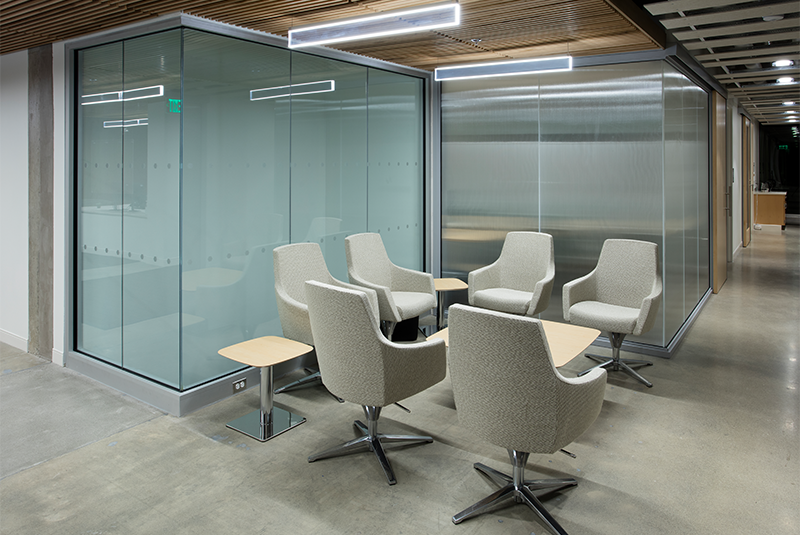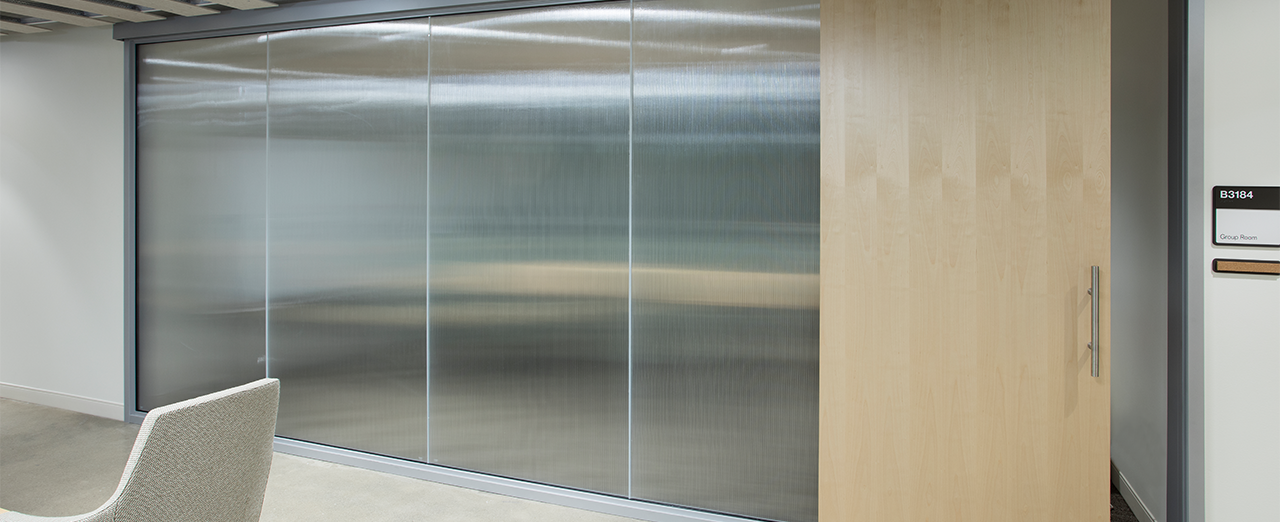
One entry point to a healthier workspace is the door itself. Sliding office doors can support healthier design goals in five major ways:
- Keeping teams connected
- Maximizing useable space to balance personal and shared space
- Adding pops of color to enhance occupant comfort
- Encouraging access to daylight
- Providing quiet spaces for concentrated work
1. Sliding office doors keep offices connected
Sliding doors with large lites of glass establish the visual connection of an open office without its disadvantages. With these doors, employees will be able to see each other and easily connect when needed while also being respectful of noise-levels.
Commercial sliding doors can also be made in sizes up to 8 feet wide without the larger swing arc trajectories of traditional oversized doors. Supporting flexible office design, these sliding office doors can be left open to make two adjacent spaces feel like one large room, allowing open and collaborative communication when necessary. They can easily be slid shut to enable a private working space when dedicated work is more beneficial.
2. Interior office doors maximize space to balance personal and shared space
Personal space is very important to office design, but it needs to be balanced. Too much distance between coworkers can lead to feelings of isolation while too little can harm productivity.
Commercial office doors that slide do not sacrifice space for swing arc trajectories, saving up to 30 square feet of useable space per door. The result is offices can have more freedom in their layout, which can help designers find the right balance between separation and connection to support the perfect ratio of personal and collaborative space.
3. Commercial sliding doors can incorporate pops of color to enhance occupant comfort
Several studies have shown colors affect people’s ability to work and learn. Knowing this, many employers are finding ways to incorporate color into their office designs. Sliding office doors can be customized with a variety of colors, adding flair and comfort to any office.
For example, a company could specify blue doors for its meeting rooms to suggest calm and organization. Alternatively, they could use deep greens to support biophilic design and ease eye fatigue. By using interior office doors to provide color accents, an employer can create a more visually appealing office as well as one that supports employee health and wellness.
4. Sliding glass doors allow access to daylight
Access to daylight not only helps promote productivity in the office, but it can also have benefits for employees after work as well. Neuroscientists have found that increasing exposure to light during work hours can help employees have more restful nights, boosting quality of life.
By specifying sliding glass office doors with large glass lites, design teams can help bring light deep within a building, supporting daylighting goals for a more comfortable and wellness-based office in general. These doors can feature transparent glass, frosted glass and several intermediate options to balance the need for privacy and natural light.
5. Sliding office doors provide acoustically isolated spaces
While open offices and highly collaborative environments have several benefits, they can create a substantial amount of distracting noise, hampering productivity when employees need to concentrate on difficult solo work.
Commercial sliding doors are a simple and effective solution for creating a more open design and supporting acoustically isolated spaces. For example, several of AD Systems’ sliding door solutions are available with perimeter and drop-down bottom seals to provide Noise Isolation Class (NIC) ratings up to 39. These doors reduce the amount of noise contamination between spaces to support productivity.
Designing for health and wellness starts with the door
Sliding office doors are not the only way an office can support employee health and wellness, but they do provide several benefits. Whether used alone or as a part in a complete system, they can help architects achieve occupant-focused design goals. AD Systems not only offers several standard options but will also work with design teams to ensure the right system is specified for the application.







